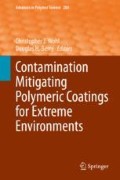Abstract
Multiple years of international trials in both oceanic and freshwater sites have led to successful easy-release coatings based on the methyl-silicone polymers now widely employed as substitutes for tributyltin- and copper-based ship bottom paints. These have been found to be too soft for harsh conditions, especially during abrasion, but do serve for useful periods in commercial and military circumstances where abrasion is not frequent. This chapter reviews abrasion-related research of the past 20 years that identifies a novel version of silicone-based coatings with a retained easy-release value of Critical Surface Tension (CST) of about 26 mN/m, compounded with a tough epoxy component that allows the two-component coating to survive and function well in extremely abrasive circumstances. This coating has been applied to a power plant’s large intake grate (“rack”) subject to debris impact and intense zebra mussel fouling, an airfoil blade coating showing significantly lower drag than competitive paints, a turbine encasement seal layer remaining functional in zebra mussel-infested waters, and an easy-release surface for flash-frozen ice, simultaneously also resisting damage by transit through ice floes. The coating is formulated using polymeric methyl-silicone granules that are dispersed within an oil-in-water multiple emulsion in an epoxy base that maintains excellent substratum adhesion while allowing the methyl-silicone-based matter to dominate and be continuously refreshed via minimum wear at the environmental interface.
References
Baier RE, Meyer AE, Forsberg RL (1997) Certification of properties of nontoxic fouling-release coatings exposed to abrasion and long-term immersion. Nav Res Rev XLIX(4):60–65
Wells AW, Meyer AE, Matousek JA, Baier RE, Neuhauser EF (1997) Nontoxic foul-release coatings for zebra mussel control. In: Waterpower ‘97: proceedings of the international conference on hydropower, vol 1. American Society of Civil Engineers, pp 451–460
Baier RE, Meyer AE, Forsberg RL, Ricotta MS (1997) Intrinsic drag reduction of biofouling-resistant coatings. In: Proceedings, emerging nonmetallic materials for the marine environment. US-pacific Rim workshop, U.S. Office of Naval Research, Honolulu, HI, pp 1–36 to 1–40
Ricotta MS (1998) Investigation of possible mechanisms for inherent drag reduction by biofouling-release coatings. MS Thesis, State University of New York at Buffalo. (expanded conclusions in Baier RE, Ricotta MS, Meyer AE, Forsberg RL, Latini LJ, Pendergast DR (2002) Drag reduction by easy release of surface-attached foulants). In: Proceedings 25th annual meeting of The Adhesion Society, pp 352–355
Siraj FM, Baier RE (2016) Water droplet contact-adhesion of ice on reference materials. In: Proceedings of the 39th annual meeting of The Adhesion Society, San Antonio, Texas, 21–24 Feb 2016
Andolina VL (2012) Evaluation of a hydrophobic ‘easy-release’ silicone-epoxy coating for maintaining underwater sealing of a sliding steel/neoprene/steel interface subject to biofouling. MS Thesis, State University of New York at Buffalo
Garti N, Smith J (1995) New non-stick epoxy-silicone water-based coatings, part I: physical and surface properties. In: Proceedings of the fifth international zebra mussel and other aquatic nuisance organisms conference, Toronto, Canada, pp 151–169
Hogan JN (1996) Sea Grant scholars: Sea Grant helps educate future decision makers. Coastlines, New York Sea Grant Institute 26(1):32–33
Baier RE, Loeb GI (1971) Multiple parameters characterizing interfacial films of a protein analogue, polymethylglutamate. In: Craver CD (ed) Polymer characterization: interdisciplinary approaches. Plenum Press, New York, pp 79–96
Meyer A, Baier R, Wood CD, Stein J, Truby K, Holm E, Montemarano J, Kavanagh J, Nedved B, Smith C, Swain G, Weibe D (2006) Contact angle anomalies indicate that surface-active eluates from silicone coatings inhibit the adhesive mechanisms of fouling organisms. Biofouling 22:411–423
Zisman WA (1964) Relation of the equilibrium contact angle to liquid and solid constitution. Contact angle, wettability, and adhesion. Advances in Chemistry Series, vol 43. American Chemical Society, Washington, pp 1–51
Baier RE (2006) Surface behaviour of biomaterials: The theta surface for biocompatibility. J Mater Sci Mater Med 17:1057–1062
ASTM D5618-94 (1994) Standard test method for measurement of barnacle adhesion strength in shear. Am Stand Test Mat, paint, tests for formulated products and applied coatings, vol 06.01
Kok M, Mertens T, Raps D, Young TM (2013) Influence of surface characteristics on insect residue adhesion to aircraft leading edge surfaces. Prog Org Coat 76:1567–1575
Kaelble DH (1970) Dispersion-polar surface tension properties of organic solids. J Adhes 2:66–81
Acknowledgments
Aspects of the work reported here were developed with support from the Office of Naval Research, Grant N00014-89-J-3101 and Sea Grant/NOAA Projects R/EMS-2 and E/IF-1. We thank Mr. John Smith of Plastic Maritime Co. for supplies of the paint ingredients, and Mr. Lucas Latini for supply of the helicopter rotor blades and towing tank fixtures. Dr. Claes Lundgren provided access to the Project THEMIS towing tank at University at Buffalo, and supervised those tests.
Author information
Authors and Affiliations
Corresponding author
Editor information
Editors and Affiliations
Rights and permissions
Copyright information
© 2018 Springer International Publishing AG
About this chapter
Cite this chapter
Baier, R., Ricotta, M., Andolina, V., Siraj, F., Forsberg, R., Meyer, A. (2018). Unique Silicone-Epoxy Coatings for Both Fouling- and Drag-Resistance in Abrasive Environments. In: Wohl, C., Berry, D. (eds) Contamination Mitigating Polymeric Coatings for Extreme Environments. Advances in Polymer Science, vol 284. Springer, Cham. https://doi.org/10.1007/12_2017_33
Download citation
DOI: https://doi.org/10.1007/12_2017_33
Published:
Publisher Name: Springer, Cham
Print ISBN: 978-3-030-45838-6
Online ISBN: 978-3-030-45839-3
eBook Packages: Chemistry and Materials ScienceChemistry and Material Science (R0)

